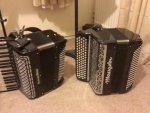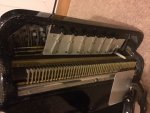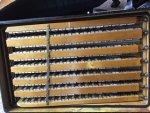Philh4955
Member
- Joined
- Dec 26, 2018
- Messages
- 11
- Reaction score
- 0
I have a Maugein C-system accordion I would like to work out which model it is if possible and wonder whether anyone can help.
It has a number 817-61E220 but I am unsure as to the significance of that. As you can see in the picture it is a 5-row (52 notes) and 120 bass. The treble is, I think, 3 voice plus cassotto (single?) and has 6 couplers (3 with cassotto 3 without). The bass has 2 registers (4 voice?)
The accordion originated from Scotland and I think is probably about 20 years old - but that may be way out!
Any help gratefully received.
It has a number 817-61E220 but I am unsure as to the significance of that. As you can see in the picture it is a 5-row (52 notes) and 120 bass. The treble is, I think, 3 voice plus cassotto (single?) and has 6 couplers (3 with cassotto 3 without). The bass has 2 registers (4 voice?)
The accordion originated from Scotland and I think is probably about 20 years old - but that may be way out!
Any help gratefully received.



